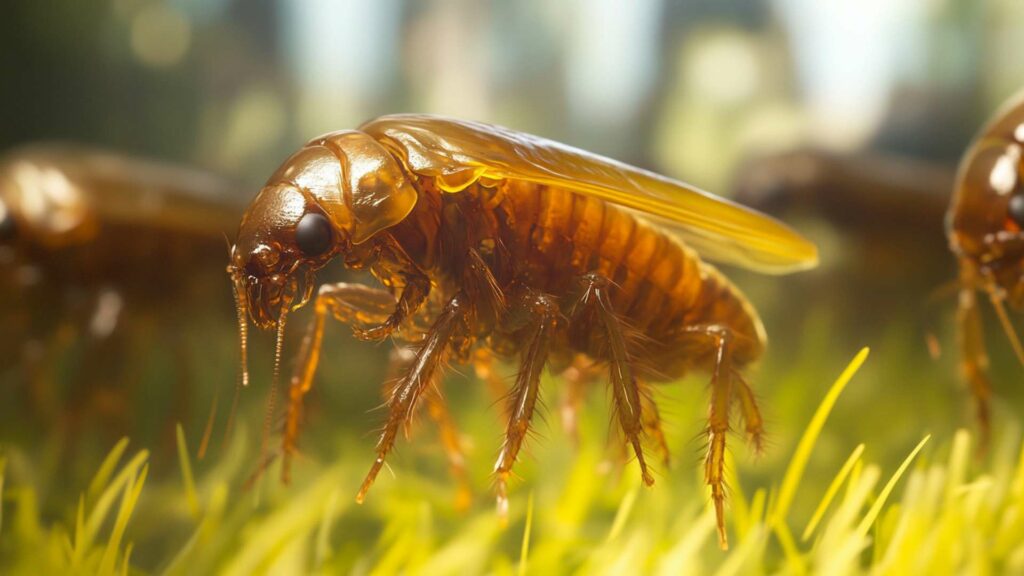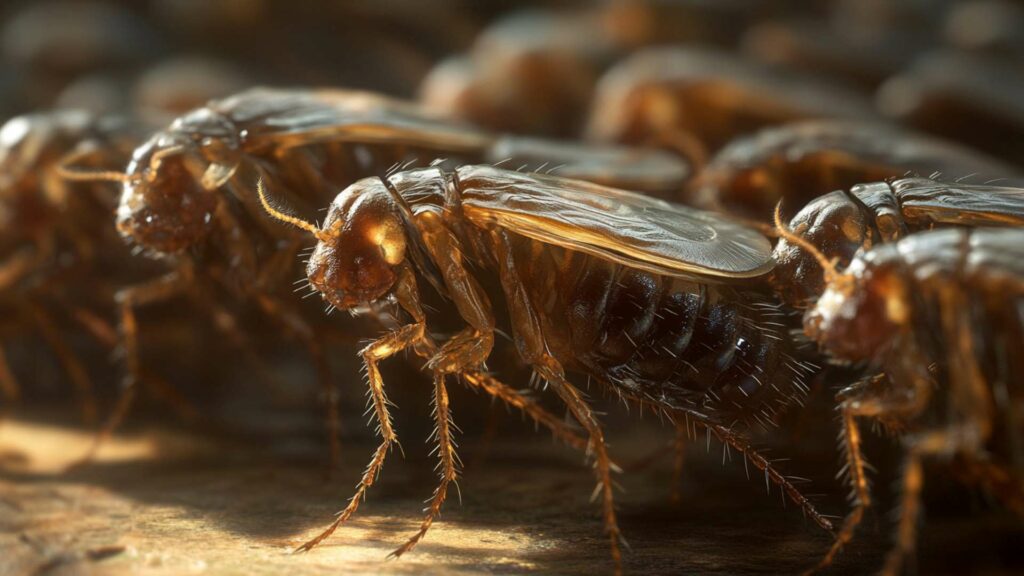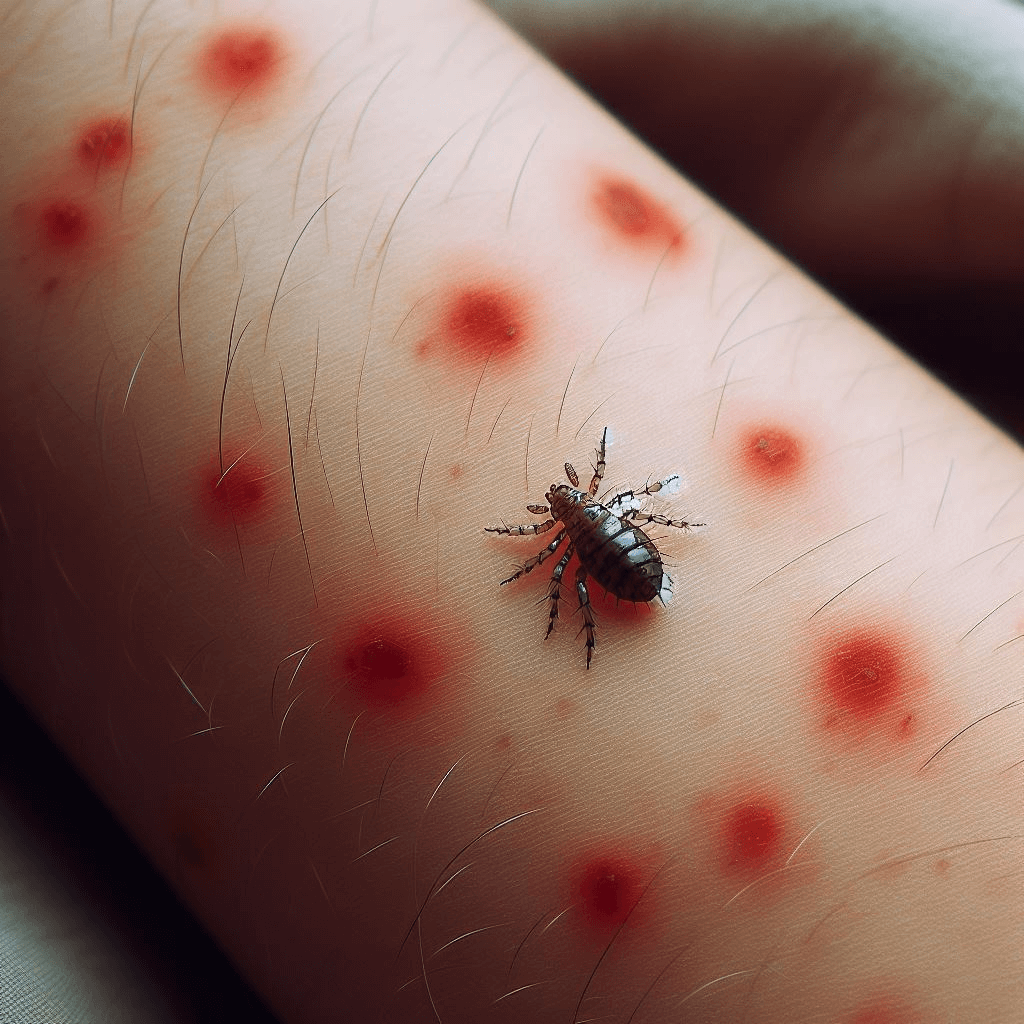Fleas, those tiny wingless insects, are notorious pests that can cause great discomfort for both humans and animals. Among the various species of fleas, the most common one responsible for causing flea bites in humans is the cat flea (scientifically known as cat fleas or Ctenocephalides felis). These minuscule creatures have flat bodies adapted for easy movement through fur or clothing and are capable of jumping impressive distances.
Fleas are blood-feeding parasites that survive by biting warm-blooded hosts. While their preferred hosts are typically cats and dogs, they can also bite humans when given the opportunity.
The female flea is particularly adept at seeking out a potential blood meal. With a keen sense of detection, she identifies body heat, exhaled carbon dioxide, and vibrations to locate a suitable host.
Explanation of How Fleas Can Bite Humans

When fleas come into contact with humans, usually through contact with flea-infested pets, wild animals, like rats, or environments, they don’t hesitate to bite. Interestingly enough, fleas do not have jaws like mosquitoes or bed bugs. Instead, they possess specialized mouthparts designed for piercing and sucking blood from their host.
To initiate feeding on a human host, a flea pierces the skin using its sharp mouthpart called a stylet. This action can often go unnoticed due to the flea’s saliva containing an anesthetic that numbs the area around the bite site.
Once catch fleas have successfully attached to their chosen spot on your body, it then begins to suck blood. It’s important to note that unlike mosquitoes which fly away after biting once, fleas tend to remain attached until they’re fully engorged with blood—making them even more annoying!
Additionally, fleas have an irritating saliva composition that may cause allergic reactions in some individuals, leading to more severe symptoms. Understanding how fleas behave and their modus operandi when it comes to biting humans is crucial.
By familiarizing ourselves with their habits, we can better identify the symptoms of flea bites in humans and take appropriate actions to alleviate discomfort and prevent further infestation. So let’s delve into the telltale signs of flea bites and how to deal with them effectively.
General Symptoms of Flea Bites

Itching and Irritation at the Bite Site
When a flea bites, it injects saliva into the skin to prevent blood coagulation, which can cause an allergic reaction in some individuals. The first sign of a flea bite is often intense itching and irritation at the site. You may find it hard to resist scratching, but try your best to avoid it as scratching can damage the skin and increase the risk of secondary infection.
Appearance of Small, Red Bumps or Welts on the Skin
One distinctive characteristic of flea bites is their appearance as small, red bumps or welts on the skin. Unlike mosquito bites that tend to be more rounded in shape, flea bites may have a slightly raised center with a reddened halo around it. These bumps can vary in size depending on individual factors such as sensitivity to flea saliva and duration of exposure.
Formation of Clusters or Lines of Bites
Fleas are notorious for their rapid feeding habits, often leaving behind clusters or lines of bites on human skin. This happens because fleas prefer warm areas close to blood vessels where they can readily access nourishment. In pet owners, for example, you might notice multiple sets of clustered bites around ankles and lower legs due to fleas living near pets’ resting areas.
Swelling and Inflammation Around the Bites
In addition to itching and redness, swelling and inflammation commonly occur around flea bite sites. This immune response aims to counteract substances present in flea saliva that trigger allergic reactions in susceptible individuals. While mild swelling is typical for most people, those with heightened sensitivity might experience more pronounced inflammation that lasts longer than usual.
These general symptoms provide helpful clues in identifying whether you’re dealing with flea bites rather than other common insect bites, such as those from mosquitos or bed bugs. Remember that fleas are small, wingless insects and typically leave a series of bites in a straight line or cluster.
If you suspect flea bites but are unsure, a thorough skin examination can assist you in identifying the characteristic patterns and traits associated with these pesky critters. In the next section, we will delve deeper into flea bites and into specific symptoms that may arise in different areas of the body as a result of flea bites.
Allergic Reactions to Flea Bites

Increased itching and discomfort compared to non-allergic individuals
For those who are allergic to flea bites, the itching and discomfort experienced can be much more intense than for those without allergies. While non-allergic individuals may experience mild itching around the bite site, allergic individuals often find themselves scratching incessantly.
This heightened sensation of itchiness can be attributed to an immune response triggered by the proteins present in flea saliva. When a flea bites, its saliva enters the skin, causing an allergic reaction in sensitive individuals.
Development of hives or a rash extending beyond the bite area
One hallmark of an allergic reaction to flea bites is the development of hives or a rash that extends beyond the immediate vicinity of the bite. These raised, red welts usually appear within minutes or hours after being bitten treat flea bites, and can spread across large areas of the body.
It’s important not to confuse these hives with mosquito bites, as they tend to be larger in size and may persist for several days. The presence of such a rash indicates that your body is mounting an immune response against flea saliva.
Severe itching leading to scratching, which may cause secondary infections
Severe itching is a characteristic feature of flea bites for allergic individuals. The constant urge to scratch can become unbearable, especially during nighttime when it disrupts sleep and exacerbates irritability.
Unfortunately, excessive scratching can lead to breaks in the skin, creating openings for bacteria from our hands or surrounding environment to enter and cause secondary infections. To prevent this from happening, it’s essential that we resist the temptation to scratch vigorously.
Relieving itching caused by allergic reactions
To relieve itching caused by allergic reactions to flea bites, several over-the-counter options are available. Topical creams containing hydrocortisone or calamine can provide temporary relief by reducing inflammation and soothing the irritated skin.
Antihistamines, either in pill or cream form, can also be effective in alleviating itching. However, if the itching persists or if you experience any signs of infection, it is advisable to seek medical attention for proper evaluation and treatment.
Remember, as unpleasant as allergic reactions to flea bites may be, prevention eliminating fleas, is always better than cure. Regularly comb your pets’ fur with a flea comb and inspect them for fleas or flea eggs.
Keep your household clean, vacuuming regularly (especially pet bedding and carpets), as this helps eliminate fleas at different stages of their life cycle. Additionally, consider treating your pets with appropriate flea control products recommended by veterinarians to prevent infestations.
By taking proactive measures to stop flea bites before they occur, you can ensure a more comfortable and itch-free existence for both you and your furry friends. Stay tuned for the next section where we delve into specific symptoms that occur when fleas bite humans in different areas of the body!
Flea Bites on the Legs and Feet
When it comes to flea bites on the legs and feet, these areas are particularly susceptible to being targeted by these wingless insects. Fleas live in environments that are favorable for their survival, such as tall grass or even within your own home if you have a flea infestation. When walking or standing in infested areas, fleas will easily jump onto your legs and feet, leaving behind an unpleasant reminder of their presence.
The first noticeable symptom of flea bites on the legs and feet is redness, often accompanied by swelling and intense itching. This occurs due to the saliva injected by the dog flea and the female flea while feeding.
The human body’s immune response triggers inflammation at the site of the bite, leading to discomfort and irritation. If scratching is excessive or not properly controlled, it can lead to further complications.
In some cases, individuals may develop blisters or pustules around the bite sites. Scratching can break the skin’s barrier, allowing bacteria from your hands or nails to enter and cause a secondary infection.
Flea Bites on the Arms and Hands
Flea bites on the arms and hands tend to occur due to frequent contact with female fleas-infested pets or contaminated objects such as blankets or carpets that harbor fleas. These tiny wingless creatures are known carriers of potential diseases that can be transmitted through their bites.
Upon being bitten by adult fleas, in these areas of your body, you may notice small red bumps that often appear in clusters. These bumps can be intensely itchy and may even become more inflamed if you scratch them excessively.
It is important to resist scratching as much as possible to prevent any further irritation or potential secondary infections. In some cases, individuals may also experience swelling around joints like wrists or fingers after being bitten by infected fleas again.
This localized swelling is caused by the body’s immune response to the flea’s saliva, which can trigger an allergic reaction. If you suspect an allergic reaction, it is advisable to seek medical attention for proper diagnosis and treatment.
Flea Bites on the Torso
When it comes to flea bites on the torso, they often manifest as multiple bites forming a line-like pattern along underwear lines or clothing edges. Fleas tend to hide and reside in fabrics, so these areas become easily accessible targets for their feeding.
Flea bites on the torso can cause significant discomfort and itchiness due to the irritation caused by the flea’s saliva. It is not uncommon for individuals with heightened sensitivity or flea allergy dermatitis to develop a more severe allergic reaction from these flea bites itch, however.
In such cases, widespread itchiness may occur beyond just the bite sites, leading to further discomfort. To alleviate symptoms in all affected areas of your body, there are various remedies you can try.
Applying over-the-counter anti-itch creams or lotions containing ingredients like hydrocortisone can provide temporary relief. You may also consider taking antihistamines if recommended by your healthcare provider to help reduce itching and inflammation caused by flea bites.
Preventing Secondary Infections from Flea Bites

Cleaning and disinfecting bite sites
Flea bites, although usually not dangerous, can lead to secondary infections if not taken care of properly. It is essential to clean and disinfect the affected area to prevent any further complications.
Start by gently washing the bite sites with mild soap and warm water. This will help remove any dirt or bacteria that may have accumulated on the skin around bite wounds.
After cleansing bug bites, it is crucial to apply a mild antiseptic or an over-the-counter antibacterial ointment on the bites. This step helps in preventing bacterial growth and reduces the risk of infection.
Look for products containing ingredients like benzalkonium chloride or povidone-iodine, as these are known for their antimicrobial properties. In addition to cleaning and applying ointment, it is vital to avoid scratching the flea bites.
Scratching can break the skin’s protective barrier, allowing bacteria from your hands or nails to enter the wound. To ease itching, you can use a cold compress or apply a hydrocortisone cream recommended by your healthcare provider.
Conclusion
Understanding the symptoms of flea bites in humans is crucial for proper identification and timely treatment of flea-borne diseases. While flea bites are generally harmless and do not carry diseases themselves, they can lead to uncomfortable symptoms such as itching, swelling, and irritation.
To prevent secondary infections from flea bites, it’s important to maintain good hygiene practices by cleaning bite sites with mild antiseptics after washing them with soap and water. Avoid scratching at all costs as it increases the risk of infection.
If you suspect a flea problem in your home or on your pets, it’s advisable to seek professional help from pest control experts. By addressing the underlying flea infestation, you can effectively reduce the chances of your pet’s fur getting more flea bites.
Remember, while it may take a few days for flea bites to heal completely, most symptoms can be managed using over-the-counter products or natural remedies like essential oils. Stay vigilant and take necessary precautions when dealing with fleas to ensure a healthy and comfortable living environment for both humans and household pets everywhere.
Eradicate Fleas with D-Termination: The Leading Pest Control Solution in Las Vegas!

Are you grappling with flea issues on your Las Vegas property? D-Termination is your trusted partner for assistance. Our proficient team specializes in eradicating flea infestations and reinstating comfort and tranquility to your living space. Say farewell to fleas—opt for D-Termination for expert pest control today!
Reach out to us at 702-919-6310 or visit dtermination.com to schedule your flea control service and reclaim your premises from these troublesome pests.
Frequently Asked Questions:
You might suspect flea bites if you notice small, itchy, red bumps on your skin.
Flea bites can lead to discomfort and itching but usually don’t cause serious illness in humans.
An allergic reaction to flea bites can result in more severe itching, redness, swelling, and even hives.
If you suspect you have fleas on or in your body, look for itching, biting sensations, and visible signs of fleas on your skin or clothing.








